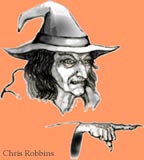
 | |
|
Double, double, toil and trouble; Fire burn and cauldron bubble. Macbeth, Wm. Shakespeare |
 Three witches cackling wickedly over a cauldron as they stir their diabolical brew: Shakespeare has indelibly printed this image onto our consciousness, an image that -- mingled with vague notions of ghosts, goblins, black cats and full moons -- has been contorted and echoed innumerable ways in film, television, print, and autumnal merchandising. Pointy black hats and three-legged iron pots are decidedly spooky to most of us, although there is nothing intrinsically horrifying about conical headwear or oversized cooking gear.
Three witches cackling wickedly over a cauldron as they stir their diabolical brew: Shakespeare has indelibly printed this image onto our consciousness, an image that -- mingled with vague notions of ghosts, goblins, black cats and full moons -- has been contorted and echoed innumerable ways in film, television, print, and autumnal merchandising. Pointy black hats and three-legged iron pots are decidedly spooky to most of us, although there is nothing intrinsically horrifying about conical headwear or oversized cooking gear.
What were those crones stirring in their pot? Why is the cauldron such a powerful symbol? Where did the idea of Hallowe'en come from? The answers lie in the ancient culture of the Celts.
Supposedly, Shakespeare took his incantations for Macbeth from actual spells, which is one reason many believe the play is cursed. However, the Bard was writing to please the witch-obsessed James I of England, and used ancient Celtic images in a purposefully sinister light to please his sovereign. Interestingly, the "eye of newt" and "bloody fingers" in the recipe may not have been the nasty things implied. "Eye" often refers to a flower's center (black-eyed Susans, for example), and bloody finger is another name for the foxglove, an English wildflower still used as a medicine for heart disease.
Not to say that the three witches in the play are simply misunderstood crone-healers innocently concocting herbal remedies, but their cultural ancestors may have been. The cauldron, now broadly associated with evil magic, was often an ordinary household item, like a toaster. Hanging over the fireplace, it could be used to steep medicinal tisanes, or simply to cook the stew.
Of course, the cauldron does have magical roots as well, as in the story of Cerridwen, a Welsh crone goddess. Two children were born to the goddess, a lovely girl and an ugly boy. In order to give the unattractive lad a little help getting along in the world, Cerridwen used six herbs to make a magical brew called greal (from which the Arthurian "holy grail" is derived). She allowed a young stranger named Gwion to stir the pot until the mixture boiled down. When Gwion burned himself on the last bubbling drops, he put his fingers in his mouth and thus acquired the magical powers Cerridwen had intended for her son. Angered, Cerridwen pursued Gwion, and each changed shape during the chase, until at last he became a seed, and she a hen who ate it. The seed took root within the goddess, and from her was born Taliesin, the legendary poet and patron of all bards. Perhaps he whispered over Shakespeare's shoulder as he wrote his Scottish tragedy.
Not only the cauldron, but also the witch's hat has origins in Wales. The national Welsh costume includes a tall, black, pointed, broad-brimmed, hat for the women. Sound familiar? (Speaking of familiars, the black cat - a symbol of Hallowe'en and bad luck in the United States - is historically a good luck omen in the British Isles.) Hallowe'en itself, now a widely marketed dress-up occasion and candy spree, derives from the ancient Celtic New Year's Eve, called Samhain (pronounced Sow'-en). This sacred passage marked the waning of the year, the end of harvest, the fading of the light. It was a time of agricultural death, and one in which the veil between the world of the living and that of the dead was believed to be the thinnest. At Samhain, communion with ghosts would be likely.
The world of the faery folk was also closer on this eve, as on midsummer night. Anyone walking alone under the Samhain moon would be wise to stay clear of faery rings - circles of mushrooms or oddly coloured grass - lest she be whisked off to the Otherworld within a hollow hill and regaled with elfin music until she forgot the world above.
The Christian church positioned All Saint's Day (November 1st), alongside the pagan Samhain, to absorb and sanctify the ancient festival. "Hallowe'en" is a hallowed, or sacred, evening because it precedes the blessed All Saints Day. The association recalls the serene but tepid "Ave Maria," following "Night on Bald Mountain" in Walt Disney's Fantasia. The gesture is clear; the darkness inevitably recedes. In our memories, however, the ghosts, goblins, demons and whirling spirits in the night sky linger long beyond the pale parade of candles and the gentle hymn.
Hallowe'en may be a mere prelude to a lesser-known religious holiday, or an excuse for film studios to churn out slasher movies, or for preschoolers to dress up as Pikachu and gobble Runts. Nevertheless, Hallowe'en has a deep hold on our imaginations; the old Celtic resonance lingers, and the night can still hold mystery and magic. Walk near a cemetery when the October moon gleams and the headstones cast long shadows on the ground. Look for white rings of toadstools shining in the grass and listen for the otherworldly music that whispers through the woods. Remember the dead who have walked this earth and passed to another place. Remember the ancient Celts whose lore remains with us, dwindled yet potent, like the last drops simmering in Cerridwen's cauldron.

|
|
||
|
© Melt Magazine 2001
|
||